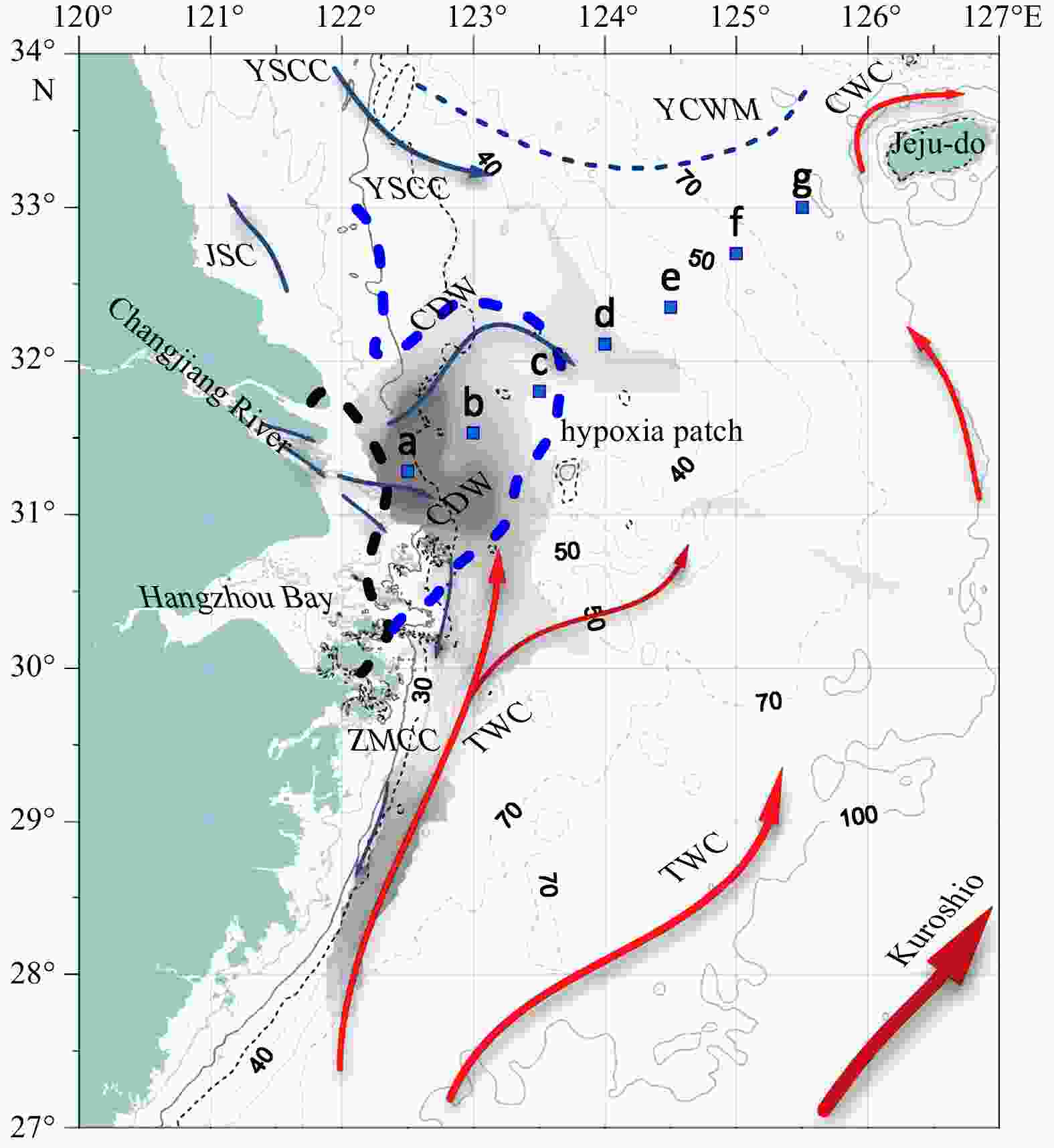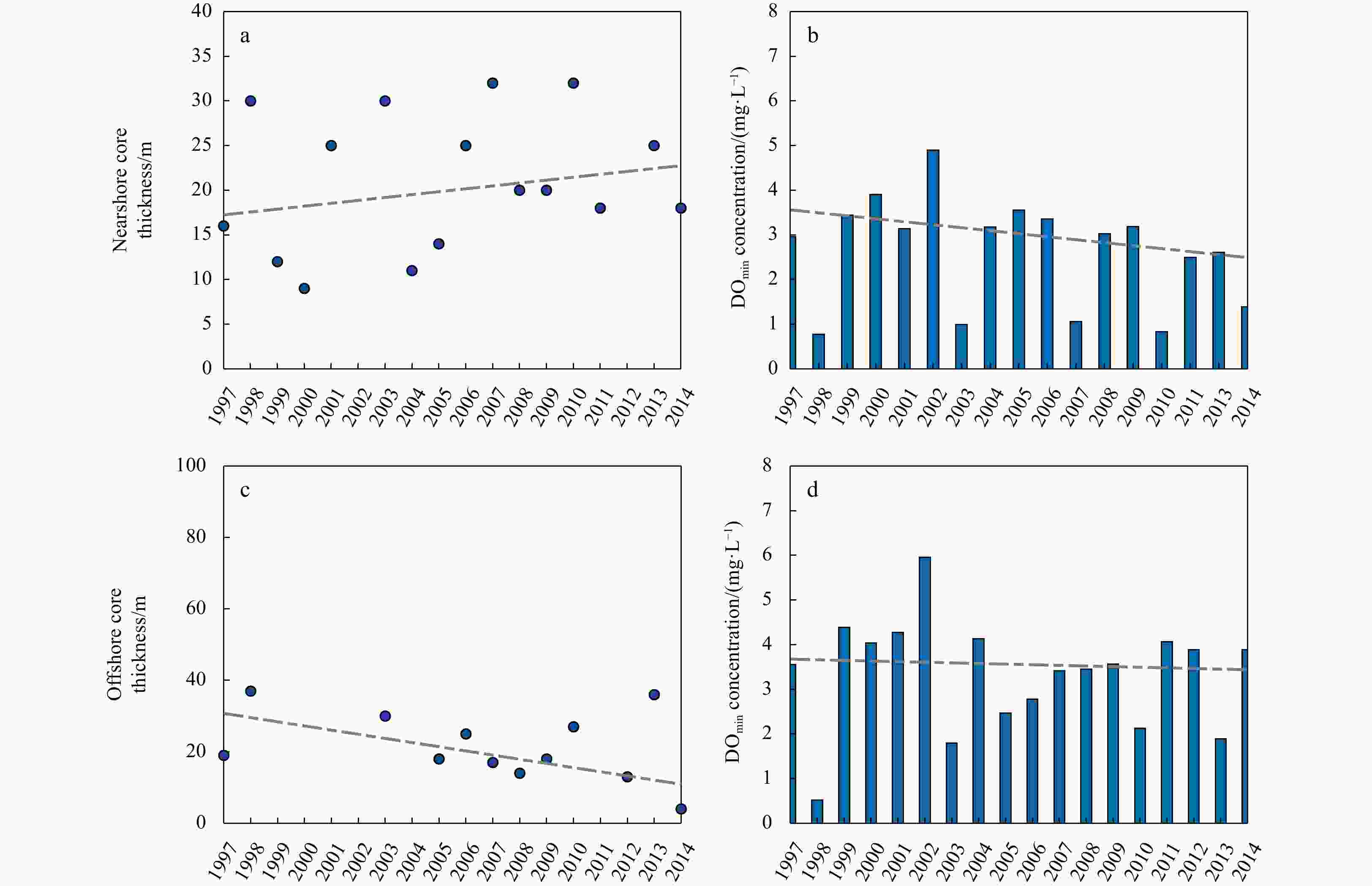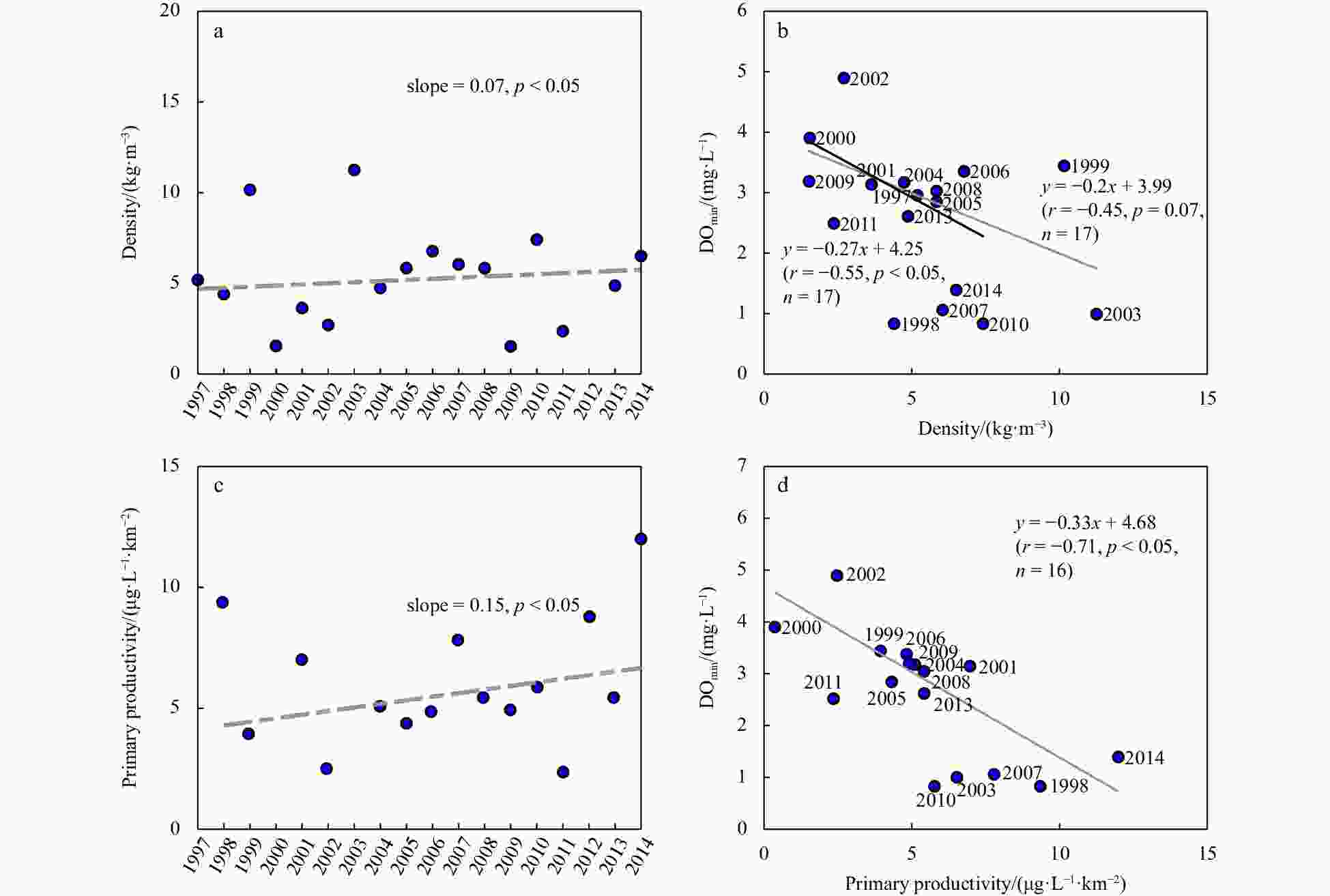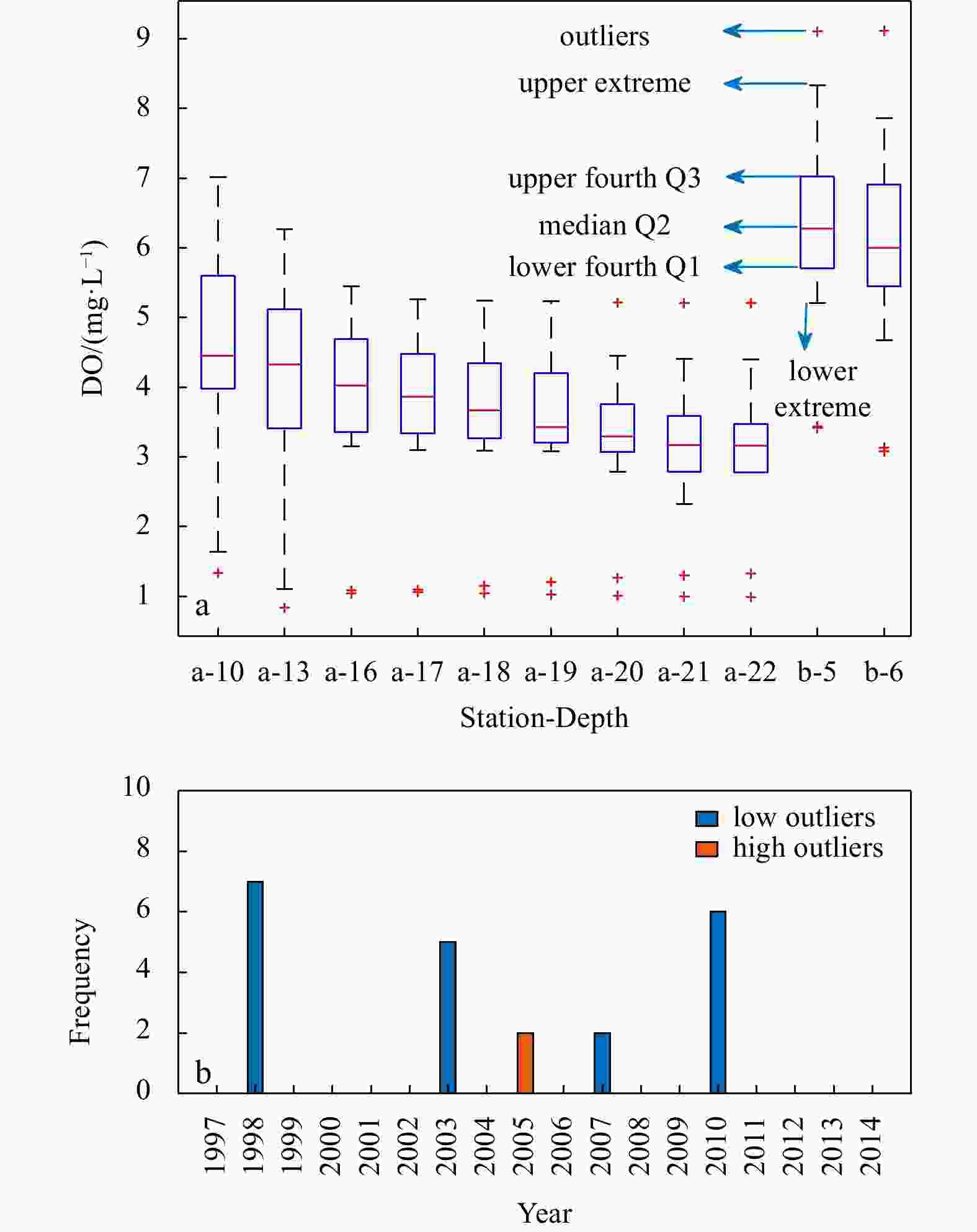Inter-annual variations of dissolved oxygen and hypoxia off the northern Changjiang River (Yangtze River) Estuary in summer from 1997 to 2014
-
Abstract: Hypoxia off the Changjiang River Estuary has been the subject of much attention, yet systematic observations have been lacking, resulting in a lack of knowledge regarding its long-term change and drivers. By revisiting the repeated surveys of dissolved oxygen (DO) and other relevant hydrographic parameters along the section from the Changjiang River Estuary to the Cheju Island in the summer from 1997 to 2014, rather different trends were revealed for the dual low-DO cores. The nearshore low-DO core, located close to the river mouth and relatively stable, shows that hypoxia has become more severe with the lowest DO descending at a rate of −0.07 mg/(L·a) and the thickness of low-DO zone rising at a rate of 0.43 m/a. The offshore core, centered around 40-m isobath but moving back and forth between 123.5°–125°E, shows large fluctuations in the minimum DO concentration, with the thickness of low-DO zone falling at a rate of −1.55 m/a. The probable factors affecting the minimum DO concentration in the two regions also vary. In the nearshore region, the decreasing minimum DO is driven by the increase in both stratification and primary productivity, with the enhanced extension of the Changjiang River Diluted Water (CDW) strengthening stratification. In the offshore region, the fluctuating trend of the minimum DO concentration indicates that both DO loss and DO supplement are distinct. The DO loss is primarily attributed to bottom apparent oxygen utilization caused by the organic matter decay and is also relevant to the advection of low-DO water from the nearshore region. The DO supplement is primarily due to weakened stratification. Our analysis also shows that the minimum DO concentration in the nearshore region was extremely low in 1998, 2003, 2007 and 2010, related to El Niño signal in these summers.
-
Key words:
- dissolved oxygen /
- low-DO /
- Changjiang River Estuary /
- interannual variations /
- dual-core
-
Figure 1. Map of two Section S1 in summer from 1997 to 2014 in the East China Sea with station number above marker. Gray shading indicates locations where hypoxia was found during historical surveys. The dashed black curve indicates the surface suspended sediment front near the Changjiang River mouth and dashed blue curve indicates the surface plume front (Li et al., 2021). The arrows indicate the direction of the summer circulation, and the red arrow represents the current, i.e., the Kuroshio and its branches, namely the Taiwan Warm Current (TWC), and the blue represents the current system with the nature of offshore water masses, including the Changjiang River Diluted Water (CDW), the Yellow Sea Coastal Current (YSCC), the Cheju Warm Current (CWC), the Yellow Sea Cold Water Mass (YCWM), the Jiangsu Shoal Current (JSC) and the Zhe-min Coastal Current (ZMCC).
Figure 2. Eighteen-year averaged DO concentration in summer. a. Trend of DO concentration; b. frequency of low DO. The isoline represents the averaged DO concentration, the shading represents the trend (a) and frequency (b) of low DO, the black dot with five-pointed star indicates the sampling location, and the black dots are the sampling point.
Figure 3. Variations in DO-relevant parameters. a, c. The thickness of the low-DO core (DO concentration <4 mg/L) in the nearshore and offshore regions along Section S1; b, d. the minimum DO concentration in the two low-DO cores along Section S1. The top two panels are the result of the nearshore core and the bottom panels are the result of the offshore core. The gray dotted lines represent the trend calculated using Sen’s slope estimator. The thickness of low-DO core is represented by subtracting the minimum depth from the maximum depth of the core where the DO concentration is less than 4 mg/L.
Figure 4. Eighteen-year averages of environmental factors in summer; temperature (a), salinity (b), density (c), nitrate concentration (d), phosphate concentration (e), and apparent oxygen utilization (f) (AOU) in Section S1. The isoline represents the average distribution of hydrographic variables, the shading represents the trend calculated using Mann-Kendall method, the black diamond indicates that the station location is significant with 95% confidence, the gray dot was not significant with 95% confidence, and the black triangle was the sampling site.
Figure 5. The trend in density stratification and primary productivity (a, c) in the nearshore region. Correlations of minimum DO and stratification and primary productivity (b, d) in the nearshore region. The gray line and words in b denote the correlations of minimum DO and stratification in 17 a, and the black line and words in b denote the correlations of minimum DO and stratification in 15 a (except for 1999 and 2003).
Figure 10. DO concentration distribution at Station a (A) and Station b (B) from 1997 to 2014; the Niño 3.4 index from 1997 to 2014. The Niño 3.4 index data from Ma et al. (2022) (C).
-
Akritas M G, Murphy S A, Lavalley M P. 1995. The theil-sen estimator with doubly censored data and applications to astronomy. Journal of the American Statistical Association, 90(429): 170–177. doi: 10.1080/01621459.1995.10476499 Brewer P G, Peltzer E T. 2009. Limits to marine life. Science, 324(5925): 347–348. doi: 10.1126/science.1170756 Carstensen J, Conley D J, Bonsdorff E, et al. 2014. Hypoxia in the Baltic Sea: biogeochemical cycles, benthic fauna, and management. Ambio, 43(1): 26–36. doi: 10.1007/s13280-013-0474-7 Chen C C, Gong G C, Shiah F K. 2007. Hypoxia in the East China Sea: one of the largest coastal low-oxygen areas in the world. Marine Environmental Research, 64(4): 399–408. doi: 10.1016/j.marenvres.2007.01.007 Chen Jianfang, Li Dewang, Jin Haiyan, et al. 2020. Changing nutrients, oxygen and phytoplankton in the East China Sea. In: Chen C T A, Guo Xinyu, eds. Changing Asia-Pacific Marginal Seas. Singapore: Springer, 155–178 Chen Jianyu, Pan Delu, Liu Mingliang, et al. 2017. Relationships between long-term trend of satellite-derived chlorophyll- a and hypoxia off the Changjiang estuary. Estuaries and Coasts, 40(4): 1055–1065. doi: 10.1007/s12237-016-0203-0 Chi Lianbao, Song Xiuxian, Yuan Yongquan, et al. 2017. Distribution and key influential factors of dissolved oxygen off the Changjiang River Estuary (CRE) and its adjacent waters in China. Marine Pollution Bulletin, 125(1-2): 440–450. doi: 10.1016/j.marpolbul.2017.09.063 Chi Lianbao, Song Xiuxian, Yuan Yongquan, et al. 2020. Main factors dominating the development, formation and dissipation of hypoxia off the Changjiang Estuary (CE) and its adjacent waters, China. Environmental Pollution, 265: 115066. doi: 10.1016/j.envpol.2020.115066 Conley D J, Bonsdorff E, Carstensen J, et al. 2009. Tackling hypoxia in the Baltic Sea: is engineering a solution?. Environmental Science & Technology, 43(10): 3407–3411. Dai Minhan, Guo Xianghui, Zhai Weidong, et al. 2006. Oxygen depletion in the upper reach of the Pearl River estuary during a winter drought. Marine Chemistry, 102(1–2): 159–169. doi: 10.1016/j.marchem.2005.09.020 Diaz R J. 2001. Overview of hypoxia around the world. Journal of Environmental Quality, 30(2): 275–281. doi: 10.2134/jeq2001.302275x Diaz R J, Rosenberg R. 2008. Spreading dead zones and consequences for marine ecosystems. Science, 321(5891): 926–929. doi: 10.1126/science.1156401 Ding Ruibin, Huang Daji, Xuan Jiliang, et al. 2019. Temporal and spatial variations of cross-shelf nutrient exchange in the East China Sea, as estimated by satellite altimetry and in situ measurements. Journal of Geophysical Research: Oceans, 124(2): 1331–1356. doi: 10.1029/2018JC014496 Frigge M, Hoaglin D C, Iglewicz B. 1989. Some implementations of the boxplot. The American Statistician, 43(1): 50–54. doi: 10.1080/00031305.1989.10475612 Gong Songbai, Gao Aiguo, Ni Guantao, et al. 2017. Progress in research of hypoxia in estuaries and coastal areas in China. Water Resources Protection (in Chinese), 33(4): 62–69. doi: 10.3880/j.issn.1004-6933.2017.04.010 Gray J S, Wu R S S, Or Y Y. 2002. Effects of hypoxia and organic enrichment on the coastal marine environment. Marine Ecology Progress Series, 238: 249–279. doi: 10.3354/meps238249 Guo Xiaoyi, Xu Bochao, Burnett W C, et al. 2020. Does submarine groundwater discharge contribute to summer hypoxia in the Changjiang (Yangtze) River Estuary?. Science of the Total Environment, 719: 137450. Hao Qiang, Chai Fei, Xiu Peng, et al. 2019. Spatial and temporal variation in chlorophyll a concentration in the Eastern China Seas based on a locally modified satellite dataset. Estuarine, Coastal and Shelf Science, 220: 220–231. Karim R, Sekine M, Ukita M. 2003. A model of fish preference and mortality under hypoxic water in the coastal environment. Marine Pollution Bulletin, 47(1–6): 25–29. doi: 10.1016/S0025-326X(02)00409-5 Li Hongliang, Chen Jianfang, Lu Yong, et al. 2011. Seasonal variation of DO and formation mechanism of bottom water hypoxia of Changjiang River Estuary. Journal of Marine Sciences (in Chinese), 29(3): 78–87. doi: 10.3969/j.issn.1001-909X.2011.03.010 Li Weiqi, Ge Jianzhong, Ding Pingxing, et al. 2021. Effects of dual fronts on the spatial pattern of chlorophyll- a concentrations in and off the Changjiang River estuary. Estuaries and Coasts, 44(5): 1408–1418. doi: 10.1007/s12237-020-00893-z Li Daoji, Zhang Jing, Huang Daji, et al. 2002. Oxygen depletion off the Changjiang (Yangtze River) Estuary. Science in China Series D: Earth Sciences, 45(12): 1137–1146. doi: 10.1360/02yd9110 Lie H J, Cho C H, Lee J H, et al. 2000. Seasonal variation of the Cheju Warm Current in the Northern East China Sea. Journal of Oceanography, 56(2): 197–211. doi: 10.1023/A:1011139313988 Lu Wenhai, Xiang Xianquan, Yang Lu, et al. 2017. The temporal-spatial distribution and changes of dissolved oxygen in the Changjiang Estuary and its adjacent waters for the last 50 a. Acta Oceanologica Sinica, 36(5): 90–98. doi: 10.1007/s13131-017-1063-6 Luo Xiaofan, Wei Hao, Fan Renfu, et al. 2018. On influencing factors of hypoxia in waters adjacent to the Changjiang estuary. Continental Shelf Research, 152: 1–13. doi: 10.1016/j.csr.2017.10.004 Ma Xiao, Liu Anqi, Zhao Qiang, et al. 2022. Temporal variation of summer hypoxia off Changjiang estuary during 1997–2014 and its association with ENSO. Frontiers in Marine Science, 9: 897063. doi: 10.3389/fmars.2022.897063 Mann H B. 1945. Nonparametric tests against trend. Econometrica, 13(3): 245. doi: 10.2307/1907187 Meng Qicheng, Zhang Wenyan, Zhou Feng, et al. 2022. Water oxygen consumption rather than sediment oxygen consumption drives the variation of hypoxia on the East China Sea shelf. Journal of Geophysical Research: Biogeosciences, 127(2): e2021JG006705. doi: 10.1029/2021JG006705 Ni Xiaobo, Huang Daji, Zeng Dingyong, et al. 2016. The impact of wind mixing on the variation of bottom dissolved oxygen off the Changjiang Estuary during summer. Journal of Marine Systems, 154: 122–130. doi: 10.1016/j.jmarsys.2014.11.010 Ning Xiuren, Lin Chun, Su Jilan, et al. 2011. Long-term changes of dissolved oxygen, hypoxia, and the responses of the ecosystems in the East China Sea from 1975 to 1995. Journal of Oceanography, 67(1): 59–75. doi: 10.1007/s10872-011-0006-7 Obenour D R, Michalak A M, Zhou Yuntao, et al. 2012. Quantifying the impacts of stratification and nutrient loading on hypoxia in the Northern Gulf of Mexico. Environmental Science & Technology, 46(10): 5489–5496. doi: 10.1021/es204481a Paerl H W. 2006. Assessing and managing nutrient-enhanced eutrophication in estuarine and coastal waters: interactive effects of human and climatic perturbations. Ecological Engineering, 26(1): 40–54. doi: 10.1016/j.ecoleng.2005.09.006 Paerl H W, Pinckney J L, Fear J M, et al. 1998. Ecosystem responses to internal and watershed organic matter loading: consequences for hypoxia in the eutrophying Neuse River Estuary, North Carolina, USA. Marine Ecology Progress Series, 166: 17–25. doi: 10.3354/meps166017 Park S, Chu P C, Lee J H. 2011. Interannual-to-interdecadal variability of the Yellow Sea Cold Water Mass in 1967–2008: characteristics and seasonal forcings. Journal of Marine Systems, 87(3–4): 177–193. doi: 10.1016/j.jmarsys.2011.03.012 Qi Jifeng. 2014. The study on the water masses, Kuroshio and water exchange in the East China Sea (in Chinese)[dissertation]. Qingdao: Institute of Oceanology, Chinese Academy of Sciences Qian Wei, Dai Minhan, Xu Min, et al. 2017. Non-local drivers of the summer hypoxia in the East China Sea off the Changjiang Estuary. Estuarine, Coastal and Shelf Science, 198: 393–399. Rabotyagov S S, Kling C L, Gassman P W, et al. 2014. The economics of dead zones: causes, impacts, policy challenges, and a model of the Gulf of Mexico hypoxic zone. Review of Environmental Economics and Policy, 8(1): 58–79. doi: 10.1093/reep/ret024 Renaud M L. 1986. Hypoxia in Louisiana coastal waters during 1983: implications for fisheries. Fishery Bulletin, 84(1): 19–26 Sen P K. 1968. Estimates of the regression coefficient based on Kendall’s tau. Journal of the American Statistical Association, 63(324): 1379–1389. doi: 10.1080/01621459.1968.10480934 Su Jilan, Huang Daji. 1995. On the current field associated with the Yellow Sea Cold Water Mass. Oceanologia et Limnologia Sinica (in Chinese), 26(S5): 1–7 Su Yusong, Li Fengqi, Wang Fengqin. 1996. Water distribution and water division in the Bohai Sea, Yellow Sea and East China Sea. Haiyang Xuebao (in Chinese), 18(6): 1–7 Sun Xiangdong, Liu Yongjun, Chen Wenwen, et al. 2010. Application of boxplot method in the validation of abnormal value of animal health data. China Animal Health Inspection (in Chinese), 27(7): 66–68 Theil H. 1992. A rank-invariant method of linear and polynomial regression analysis. In: Raj B, Koerts J, eds. Henri Theil’s Contributions to Economics and Econometrics. Dordrecht: Springer Tian Di, Zhou Feng, Zhang Wenyan, et al. 2022. Effects of dissolved oxygen and nutrients from the Kuroshio on hypoxia off the Changjiang River estuary. Journal of Oceanology and Limnology, 40(2): 515–529. doi: 10.1007/s00343-021-0440-3 Vaquer-Sunyer R, Duarte C M. 2008. Thresholds of hypoxia for marine biodiversity. Proceedings of the National Academy of Sciences of the United States of America, 105(40): 15452–15457. doi: 10.1073/pnas.0803833105 Wan Yuming, Mei Xiuning, Zhou Yuhua. 1999. The medium-range process analysis of the flood disasters in the Yangtze River Basin in 1998 flood season. Meteorological Monthly (in Chinese), 25(9): 24–30 Wang Baodong. 2009. Hydromorphological mechanisms leading to hypoxia off the Changjiang estuary. Marine Environmental Research, 67(1): 53–58. doi: 10.1016/j.marenvres.2008.11.001 Wang Jiangtao, Cao Jing. 2012. Variation and effect of nutrient on phytoplankton community in Changjiang Estuary during last 50 years. Marine Environmental Science, 31(3): 310–315. doi: 10.3969/j.issn.1007-6336.2012.03.002 Wang Bin, Chen Jianfang, Jin Haiyan, et al. 2023. Subsurface oxygen minima regulated by remineralization and bottom flushing along 123°E in the inner East China Sea. Frontiers in Marine Science, 9: 1081975. doi: 10.3389/fmars.2022.1081975 Wang Dianlai, Liu Wenping, Huang Xinyuan. 2013. Trend analysis in vegetation cover in Beijing based on Sen+Mann-Kendall method. Computer Engineering and Applications (in Chinese), 49(5): 13–17. doi: 10.3778/j.issn.1002-8331.1206-0282 Wang Dianlai, Su Aixia. 2019. Analysis of student’s score based on box plot. China Educational Technology & Equipment (in Chinese), (6): 98–99,106. doi: 10.3969/j.issn.1671-489X.2019.06.098 Wang Baodong, Wei Qinsheng, Chen Jianfang, et al. 2012. Annual cycle of hypoxia off the Changjiang (Yangtze River) Estuary. Marine Environmental Research, 77: 1–5. doi: 10.1016/j.marenvres.2011.12.007 Wang Wentao, Yu Zhiming, Song Xiuxian, et al. 2022. Hypoxia formation in the East China Sea by decomposed organic matter in the Kuroshio Subsurface Water. Marine Pollution Bulletin, 177: 113486. doi: 10.1016/J.MARPOLBUL.2022.113486 Wang Yawei, Zhai Panmao, Tian Hua. 2006. Extreme high temperatures in southern China in 2003 under the background of climate change. Meteorological Monthly (in Chinese), 32(10): 27–33. doi: 10.3969/j.issn.1000-0526.2006.10.004 Wei Hao, He Yunchang, Li Qingli, et al. 2007. Summer hypoxia adjacent to the Changjiang Estuary. Journal of Marine Systems, 67(3–4): 292–303. doi: 10.1016/j.jmarsys.2006.04.014 Wei Qinsheng, Wang Baodong, Chen Jianfang, et al. 2015. Recognition on the forming-vanishing process and underlying mechanisms of the hypoxia off the Yangtze River estuary. Science China: Earth Sciences, 58(4): 628–648. doi: 10.1007/s11430-014-5007-0 Wei Qinsheng, Wang Baodong, Zhang Xuelei, et al. 2021a. Contribution of the offshore detached Changjiang (Yangtze River) Diluted Water to the formation of hypoxia in summer. Science of the Total Environment, 764: 142838. doi: 10.1016/j.scitotenv.2020.142838 Wei Qinsheng, Yao Qingzhen, Wang Baodong, et al. 2019. Deoxygenation and its controls in a semienclosed shelf ecosystem, Northern Yellow Sea. Journal of Geophysical Research: Oceans, 124(12): 9004–9019. doi: 10.1029/2019JC015399 Wei Qinsheng, Yao Peng, Xu Bochao, et al. 2021b. Coastal upwelling combined with the river plume regulates hypoxia in the Changjiang estuary and adjacent inner East China Sea shelf. Journal of Geophysical Research: Oceans, 126(11): e2021JC017740. doi: 10.1029/2021JC017740 Wishner K F, Seibel B A, Roman C, et al. 2018. Ocean deoxygenation and zooplankton: very small oxygen differences matter. Science Advances, 4(12): eaau5180. doi: 10.1126/sciadv.aau5180 Wu Hui, Zhu Jianrong, Shen Jian, et al. 2011. Tidal modulation on the Changjiang River plume in summer. Journal of Geophysical Research: Oceans, 116(C8): C08017. doi: 10.1029/2011JC007209 Xuan Jiliang, Huang Daji, Zhou Feng, et al. 2012. The role of wind on the detachment of low salinity water in the Changjiang Estuary in summer. Journal of Geophysical Research: Oceans, 117(C10): C10004. doi: 10.1029/2012JC008121 Yin Kedong, Lin Zhifeng, Ke Zhiyuan. 2004. Temporal and spatial distribution of dissolved oxygen in the Pearl River Estuary and adjacent coastal waters. Continental Shelf Research, 24(16): 1935–1948. doi: 10.1016/j.csr.2004.06.017 Zhang Haiyan, Fennel K, Laurent A, et al. 2020. A numerical model study of the main factors contributing to hypoxia and its interannual and short-term variability in the East China Sea. Biogeosciences, 17(22): 5745–5761. doi: 10.5194/bg-17-5745-2020 Zhang J, Liu S, Ren J, et al. 2007. Nutrient gradients from the eutrophic Changjiang (Yangtze River) Estuary to the oligotrophic Kuroshio waters and re-evaluation of budgets for the East China Sea Shelf. Progress in Oceanography, 74(4): 449–478. doi: 10.1016/j.pocean.2007.04.019 Zhang Wenxia, Moriarty J M, Wu Hui, et al. 2021. Response of bottom hypoxia off the Changjiang River Estuary to multiple factors: a numerical study. Ocean Modelling, 159: 101751. doi: 10.1016/J.OCEMOD.2021.101751 Zhang S, Wang Q, Lü Y, et al. 2008. Observation of the seasonal evolution of the Yellow Sea Cold Water Mass in 1996–1998. Continental Shelf Research, 28(3): 442–457. doi: 10.1016/j.csr.2007.10.002 Zhang Wenxia, Wu Hui, Hetland R D, et al. 2019. On mechanisms controlling the seasonal hypoxia hot spots off the Changjiang River estuary. Journal of Geophysical Research: Oceans, 124(12): 8683–8700. doi: 10.1029/2019jc015322 Zhang Jing, Xiao Tian, Huang Daji, et al. 2016. Editorial: Eutrophication and hypoxia and their impacts on the ecosystem of the Changjiang Estuary and adjacent coastal environment. Journal of Marine Systems, 154: 1–4. doi: 10.1016/j.jmarsys.2015.10.007 Zhao Qiang, Cai Yanhong, He Shanfang, et al. 2015. Optimal interpolation assimilation experiments based on the data from section investigation in the East China Sea. Marine Science Bulletin (in Chinese), 34(3): 275–282. doi: 10.11840/j.issn.1001-6392.2015.03.006 Zhao Huade, Kao Shuhji, Zhai Weidong, et al. 2017. Effects of stratification, organic matter remineralization and bathymetry on summertime oxygen distribution in the Bohai Sea, China. Continental Shelf Research, 134: 15–25. doi: 10.1016/j.csr.2016.12.004 Zhou Feng, Chai Fei, Huang Daji, et al. 2017. Investigation of hypoxia off the Changjiang Estuary using a coupled model of ROMS-CoSiNE. Progress in Oceanography, 159: 237–254. doi: 10.1016/j.pocean.2017.10.008 Zhou Feng, Chai Fei, Huang Daji, et al. 2020. Coupling and decoupling of high biomass phytoplankton production and hypoxia in a highly dynamic coastal system: the Changjiang (Yangtze River) estuary. Frontiers in Marine Science, 7: 259. doi: 10.3389/fmars.2020.00259 Zhou Feng, Huang Daji, Ni Xiaobo, et al. 2010. Hydrographic analysis on the multi-time scale variability of hypoxia adjacent to the Changjiang River Estuary. Acta Ecologica Sinica (in Chinese), 30(17): 4728–47407 Zhou Feng, Qian Zhouyi, Liu Anqi, et al. 2021a. Recent progress on the studies of the physical mechanisms of hypoxia off the Changjiang (Yangtze River) Estuary. Journal of Marine Sciences (in Chinese), 39(4): 22–38. doi: 10.3969/j.issn.1001-909X.2021.04.003 Zhou Mingjiang, Shen Zhiliang, Yu Rencheng. 2008. Responses of a coastal phytoplankton community to increased nutrient input from the Changjiang (Yangtze) River. Continental Shelf Research, 28(12): 1483–1489. doi: 10.1016/j.csr.2007.02.009 Zhou Feng, Xuan Jiliang, Ni Xiaobo, et al. 2009. A preliminary study on variations of the Changjiang Diluted Water between August 1999 and 2006. Acta Oceanologica Sinica, 28(6): 1–11 Zhou Jun, Zhu Zhuoyi, Hu Huanting, et al. 2021b. Clarifying water column respiration and sedimentary oxygen respiration under oxygen depletion off the Changjiang estuary and adjacent East China Sea. Frontiers in Marine Science, 7: 623581. doi: 10.3389/fmars.2020.623581 Zhu Zhuoyi, Wu Hui, Liu Sumei, et al. 2017. Hypoxia off the Changjiang (Yangtze River) estuary and in the adjacent East China Sea: quantitative approaches to estimating the tidal impact and nutrient regeneration. Marine Pollution Bulletin, 125(1–2): 103–114. doi: 10.1016/j.marpolbul.2017.07.029 Zhu Zhuoyi, Zhang Jing, Wu Ying, et al. 2011. Hypoxia off the Changjiang (Yangtze River) Estuary: oxygen depletion and organic matter decomposition. Marine Chemistry, 125(1–4): 108–116. doi: 10.1016/j.marchem.2011.03.005 Zhu Jianrong, Zhu Zhuoyi, Lin Jun, et al. 2016. Distribution of hypoxia and pycnocline off the Changjiang Estuary, China. Journal of Marine Systems, 154: 28–40. doi: 10.1016/j.jmarsys.2015.05.002 Zou Emei, Guo Binghuo, Tang Yuxiang, et al. 2001. An analysis of summer hydrographic features and circulation in the southern Yellow Sea and the northern East China Sea. Oceanologia et Limnologia Sinica (in Chinese), 32(3): 340–347. doi: 10.3321/j.issn:0029-814X.2001.03.016 -

 点击查看大图
点击查看大图
计量
- 文章访问数: 126
- HTML全文浏览量: 56
- 被引次数: 0




 下载:
下载:










